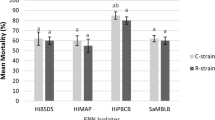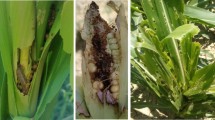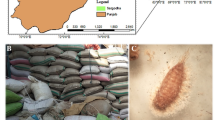Abstract
Ten indigenous entomofungal strains of Beauveria bassiana, Metarhizium anisopliae, and M. rileyi were evaluated against 2nd instar larvae of the maize fall armyworm (FAW) Spodptera frugiperda (J. E. Smith) (Lepidoptera: Noctuidae) in a laboratory bioassay. Among the ten strains tested, M. anisopliae ICAR-NBAIR Ma-35 caused 67.8% mortality, followed by B. bassiana ICAR-NBAIR Bb-45 with 64.3%, and ICAR-NBAIR Bb-11 with 57.1% mortality. Rest of the isolates showed 10.7–28.6% mortality. ICAR-NBAIR Ma-35 showed LC50 of 1.1 × 107 spores/ml and LT50 at 1 × 108 spores/ml is 86.04 h and ICAR-NBAIR Bb-45 showed LC50 of 1.9 × 107 spores/ml and LT50 at 1 × 108 spores/ml is 88.30 h. Field evaluation with these two promising strains were conducted against maize fall armyworm for 2 years (2018 and 2019) at ICAR-National Bureau of Agricultural Insect Resources experimental farm, Bengaluru, Karnataka, India. Field trial results indicated 68 and 69% reduction of FAW infestation and 55 and 62% increase in yield in the plots treated with M. anisopliae ICAR-NBAIR Ma-35/B. bassiana ICAR-NBAIR Bb-45, respectively, during 2018. In 2019, 70 and 76% reduction of FAW infestation and 44 and 55% increase in yield were observed in the plots treated with these two entomofungal pathogens, respectively.
Similar content being viewed by others
Background
The maize fall armyworm (FAW), Spodoptera frugiperda (J. E. Smith) (Lepidoptera: Noctuidae) was reported for the first time in India in 2018. It was widely distributed in Karnataka regions like Chikkaballapur, Hassan, Shivamogga, Davanagere, Bangalore, and Chitradurga during July–August 2018 (Shylesha et al.2018). The FAW is native of the tropical and sub-tropical regions of North, Central, and South America (Chittenden 1901; Luginbill 1928). In Africa, first report of fall armyworm on maize plants was made in 2016 (Goergen et al.2016). It has become invasive and threatened the food security in Africa causing more than 200 million people whose staple crop is maize. In the absence of proper control methods, S. frugiperda has the potential to cause maize yield losses of 8.3 to 20.6 million tonnes per annum in Africa. The value of crop losses is estimated between US$ 2.5 and 6.2 billion (Day et al. 2017). In addition, the pest is known to be highly polyphagous, spreading to other crops from the invaded regions (Goergen et al. 2016). The application of chemical insecticides is unsustainable because it develops insecticide resistance, cost-effective, effects natural enemies, and environmental hazards as well as health risks. Therefore, it is important to minimize the use of insecticides and need to develop sustainable IPM technologies against S. frugiperda for safe, ecofriendly management practices in India (Abrahams et al. 2017 and Yu et al.2003). FAW larvae are susceptible to entomopathogenic microorganisms, such as bacteria, fungi, nematodes, viruses, and protozoa (Molina-Ochoa et al.2003; Ríos-Velasco et al. 2010). Native strains of entomopathogenic fungi as an alternative to chemical insecticides have to be evaluated against maize fall armyworm.
The present study was undertaken up to evaluate the entomofungal pathogens against S. frugiperda under laboratory and field-level conditions.
Materials and methods
Insect culture
The second instar larvae and egg patches of Spodoptera frugiperda was obtained from mass production unit of ICAR-NBAIR, Bangalore, Karnataka, India, were used for the bioassay.
Source of fungal cultures
Three strains of Beauveria bassiana (Balsamo) Vuillemin (Ascomycetes: Hypocreales: Cordycipitaceae) (ICAR-NBAIR Bb-5a, Bb-11 Bb-45), five strains of Metarhizium anisopliae (Metchnikoff) Sorokin (Ascomycetes: Hypocreales: Clavicipitaceae) (ICAR-NBAIR Ma-4, Ma-35, Ma-11, Ma-14a, Ma-15), and two strains of M. rileyi (Farlow) Kepler S.A. Rehner & Humber (Ascomycetes: Hypocreales: Clavicipitaceae) (ICAR-NBAIR Nr-1 and NrSf-1) derived from insect and soil samples of different geographical locations of India were maintained in the culture repository at the National Bureau of Agricultural Insect Resources (NBAIR), Bangalore, India, were used in this study. All these isolates were molecular characterized and sequenced using ITS region and were deposited in NCBI GenBank database (Table 1).
Laboratory bioassay
Fungal spore suspension
Each fungal isolate was grown on broken rice for laboratory bioassay. Spore suspension was prepared by taking 1 g of 15 days old conidiated rice in 9 ml of sterile distilled water containing 0.01% Tween 80. The suspension was filtrated through three layers of muslin cloth to get hyphal-free spore suspension, and the spore concentration was adjusted to various concentrations like (1 × 104, 1 × 105, 1 × 106, 1 × 107, and 1 × 108 spores/ml) using Neubauer’ s improved hemocytometer.
In vitro screening
The 2nd instar larvae (10 larvae/replication-3 replications) of S. frugiperda were dipped in the suspension containing 1 × 108 spores/ml for 15 s. The treated larvae were transferred into plastic containers and supplied with fresh detached maize leaves. Then the larvae were maintained under controlled conditions of 25 ± 2 °C temperature and 70 ± 5% relative humidity for 10 days. Fresh maize leaves were provided as a food to the larvae in 24 h interval. Controls were treated with sterile water containing 0.01% Tween 80. The observation on mortality due to fungal infection was carefully noted and recorded. The percent mortality of the larvae for each isolate was calculated using Abbott’s formula (Abbott, 1925). The data were subjected to one-way analysis of variance (ANOVA) using statistical software SPSS windows version 20.0. Further studies were carried out using promising isolates.
where n = insect population, T = treated, Co = control
The egg patches of S. frugiperda laid on maize leaves were used for bioassay studies of two promising strains (30 eggs/replication-5 replications). Each egg patch containing 30 eggs were dipped in the spore suspension containing 1 × 108 spores/ml for 15 s and the treated eggs were maintained on maize leaves under controlled conditions of 25 ± 2 °C temperature and 70 ± 5% relative humidity until they hatched. Similarly, the eggs in the untreated control were treated using sterile distilled water and maintained on maize leaves. Observations on egg hatching were recorded carefully at 24 intervals for a period of 5 days.
Concentration and time mortality studies
Two promising isolates were subjected to dose and time mortality studies. Five spore concentrations (1 × 104, 1 × 105, 1 × 106, 1 × 107, and 1 × 108 spores−1) were used to study LC50 and bioassays were carried out as described above. In case of time mortality studies, single concentration (1 × 108 spores−1) was used to determine LT50. The dose and time to kill 50% of the population (LC50 and LT50) were determined by probit analysis (Finney 1971). Statistical analysis was done using SPSS windows version 20.0.
Field evaluation
The field trials were carried out using 2 promising strains of B. bassiana ICAR-NBAIRBb-45 and M. anisopliae ICAR-NBAIRMa-35 on maize FAW at ICAR-NBAIR Attur Farm, Bengaluru, Karnataka, India, during 2018 (November to February) and 2019 (June to September).
The field trials were laid out in completely randomized block design with 3 treatments and eight replications using maize hybrid variety (BRMH-1) obtained from Karnataka State Seeds Corporation, India, for this study. The maize seeds were sown manually in the experimental plot with a plot size of 5 m × 6 m for each treatment and spacing of 60 cm × 30 cm were maintained and irrigated regularly. All the agronomic practices with recommended doses of fertilizers were followed to maintain good plant health till harvest of crop as per package of practice by UAS, Bengaluru, Karnataka, India, and harvesting was done manually. The talc formulations of these isolates were applied at the dose of 5 g/l (1 × 108 Cfu/g) during 20, 30, and 40 days after sowing (10 days interval) of maize seeds in the experimental field during both the seasons as soon as pest incidence was observed. Pre- and post-observations on number of plants infested with FAW were recorded after 5 days of treatment. The plant infestation with FAW was recorded based on the number of plants infested by FAW out of 120 plants (15 plants per replication in each treatment, total 120 plants). The percent reduction in plants infestation by FAW was calculated. Yield was recorded at the time of crop harvest for each treatment. The data was subjected to statistical analysis for drawing inferences using SPSS windows version 20.0. Significant level was set at 0.05 and the means were separated by Turkey test.
Results and discussion
Laboratory bioassay
Among the ten strains tested, M. anisopliae ICAR-NBAIR Ma-35 caused 67.8% mortality followed by B. bassiana ICAR-NBAIR Bb-45 with 64.3% and Bb-11 with 57.1% mortality. The rest of the strains showed 10.7–28.6% mortality (Table 1). No mortality was observed on FAW eggs when treated with these promising isolates. García et al. (2011) reported 96.6 and 78.6% mortality with B. bassiana and M. anisopliae strains, respectively on 2nd instar larvae of the FAW at a concentration of 1 × 109 conidia/ml. Aktuse et al. (2019) reported that, M. anisopliae isolates showed 92 and 97% mortality on FAW eggs and neonate larvae, respectively, and were less susceptible to 2nd instar larvae of FAW, whereas only B. bassiana showed 30% mortality on 2nd instar larvae of FAW in Kenya. Cruz-Avalos et al. (2019) reported that, M. anisopliae and B. bassiana isolates showed 19 and 100% mortality on FAW eggs and neonate larvae, respectively. Morales-Reyes et al. (2013) reported that M. anisopliae and B. bassiana at 106, 107 concentrations showed in the range of 45 to 65% mortality, respectively, on the 2nd instar larvae of FAW in laboratory bioassay. Obtained results showed that B. bassiana and M. anisopliae were effective against 2nd instar larvae of FAW with 10–67% mortality where no mortality was observed on eggs. Fang et al. (2005) reported that entomopathogenic fungal enzymes play an important role on virulence of insect pests, which varies with different strains.
Concentration and time mortality studies
ICAR-NBAIR Ma-35 showed LC50 of 1.1 × 107 spores ml−1 and LT50 of 86.04 h and ICAR-NBAIR Bb-45 showed LC50 of 1.9 × 107 spores ml−1 and LT50 of 88.30 h respectively (Tables 2 and 3). Cruz-Avalos et al. (2019) found that 19 and 100% mortality was observed with B. bassiana and M. anisopliae strains, respectively, and LC50 in the range of 7.4 × 104 to 36 × 105 conidia−1 on FAW eggs and neonate larvae, respectively, in Mexico. Also, M. anisopliae isolate CP-MA1 at the dose of 5.3 × 105 conidia/ml showed 72.5% mortality of 3rd instar larvae of FAW (Romero-Arenas et al. 2014).
Field evaluation
In 2018, significantly low percentages of plant infestation by FAW were observed after 3 sprays of M. anisopliae ICAR-NBAIR Ma-35 (20.28%) and B. bassiana ICAR-NBAIR Bb-45 (21.39%) compared to the untreated control (66.94%). Cob yield was significantly high in M. anisopliae ICAR-NBAIR Ma-35 (27.08 Q ha−1) and B. bassiana ICAR-NBAIR Bb-45 (22.68%) compared to the untreated control (10.18 Q ha−1) (Table 4). In 2019, significantly lower percentage of plant infestation by FAW was observed after 3 sprays of M. anisopliae ICAR-NBAIR Ma-35 (11.67%) and B. bassiana ICAR-NBAIR Bb-45 (14.44%) than the untreated control (48.89%). Cob yield was significantly high in M. anisopliae ICAR-NBAIR Ma-35 (30.52 Q ha−1) followed by B. bassiana ICAR-NBAIR Bb-45 (24.33%) compared to the untreated control (13.52 Q ha−1) (Table 5). No other pests and diseases were observed in the treated and untreated experimental plot. The results indicate the efficacy of M. anisopliae ICAR-NBAIR Ma-35 and B. bassiana ICAR-NBAIR-Bb-45 against maize FAW. Field trial with M. rileyi (Nomuraea rileyi) against FAW in Dharwad district of Karnataka, India, showed 58–62% of pest reduction after 15 days of spraying (Mallapur et al. 2018). Obtained results showed that M. anisopliae ICAR-NBAIR Ma-35 and B. bassiana ICAR-NBAIR Bb-45 showed 68 and 69% of reduction, respectively, of FAW infestation and 55 and 62% increase in the yield in 2018, respectively. In 2019, they showed 70 and 76% of reduction of FAW infestation and 44 and 55% increase in the yield.
Conclusion
Based on 2-year field trials conducted in FAW infested plots in Karnataka state of India, M. anisopliae ICAR-NBAIR Ma-35 and B. bassiana ICAR-NBAIR-Bb-45 were recommended as potential isolates for management of FAW in maize crop, as the plots treated with this biocontrol agent showed minimum infestation levels of FAW and considerable increases in the yield than the untreated control.
Availability of data and materials
All data are available in the article and the materials used in this work are of high quality and grade.
Abbreviations
- ICAR:
-
Indian Council of Agricultural Research
- NBAIR:
-
National Bureau of Agricultural Insect Resources
- NCBI:
-
National Center for Biotechnology Information
- UAS:
-
University of Agricultural Sciences
- FAW:
-
Fall armyworm
- IPM:
-
Integrated pest management
- Bb:
-
Beauveria bassiana
- Ma:
-
Metarhizium anisopliae
- Nr:
-
Nomuraea rileyi (Metarhizium rileyi)
- Cfu:
-
Colony forming units
- LC50 :
-
Lethal concentration
- LT50 :
-
Lethal time
References
Abbott WS (1925) A method of computing the effectiveness of an insecticide. J Econ Entomol 18:265–267
Abrahams P, Bateman M, Beale T, Clottey V, Cock M, Colmenarez Y, Corniani N, Day R, Early R, Godwin J et al (2017) Fall armyworm: impacts and implications for Africa. CABI, UK
Akutse KS, Kimemia JW, Ekesi S, Khamis FM, Ombura OL, Subramanian S (2019) Ovicidal effects of entomopathogenic fungal isolates on the invasive fall armyworm Spodoptera frugiperda (Lepidoptera: Noctuidae). J Appl Entomol. https://doi.org/10.1111/jen.12634
Chittenden FH (1901) The fall armyworm in 1889. USDA Div Entomol Bull 23:78–85
Cruz-Avalos AM, Bivián-Hernández MA, Ibarra JE, Rincón-Castro MCD (2019) High virulence of Mexican entomopathogenic fungi against fall armyworm, (Lepidoptera: Noctuidae). J Econ Entomol 112:99–107
Day R, Abrahams P, Bateman M, Beale T, Clottey V, Cock M, Colmenarez Y, Corniani N, Early R, Godwin J et al (2017) Fall armyworm: impacts and implications for Africa. Outlooks Pest Manag 28:196–201
Fang W, Leng B, Xiao Y, Jin K, Ma J, Fan Y, Feng J, Yang X, Zhang Y, Pei Y (2005) Cloning of Beauveria bassiana chitinase gene Bbchit1 and its application to improve fungal strain virulence. Appl Environ Microbiol 71:363–370
Finney DJ (1971) Probit analysis, 3rd edn. Cambridge University Press, Cambridge
García C, González MB, Bautista N (2011) Pathogenicity of isolates of entomopathogenic fungi against Spodoptera frugiperda (Lepidoptera: Noctuidae) and Epilachna varivestis (Coleoptera: Coccinellidae). Rev Colomb Entomol 37:217–222
Goergen G, Kumar PL, Sankung SB, Togola A, Tamò M (2016) First report of outbreaks of the fall armyworm Spodoptera frugiperda (J.E. Smith) (Lepidoptera, Noctuidae), a new alien invasive pest in West and Central Africa. PLoS ONE 11:10
Luginbill P (1928) The fall armyworm. USDA Technical Bulletin No. 34
Mallapur CP, Naik AK, Hagari S, Praveen T, Patil RK, Lingappa S (2018) Potentiality of Nomuraea rileyi (Farlow) Samson against the fall armyworm, Spodoptera frugiperda (J E Smith) infesting maize. J Entomol Zool Stud 6:1062–1067
Molina-Ochoa J, Lezama-Gutierrez R, Gonzalez Ramirez M, Lopez-Edwards M, Rodriguez-Vega M.A, Arceo-Palacios F (2003) Pathogens and parasitic nematodes associated with populations of fall armyworm (Lepidoptera: Noctuidae) larvae in Mexico. Fla Entomol, 86:244–253. https://doi.org/10.1653/0015-4040(2003)
Morales-Reyes C, Rodriguez-Contreras J, Sanchez-Pedraza F, E. Rosales-Escobar O, Hernandez-Juarez A, Felipe-Victoriano M, Sanchez-Peña RS (2013) Activity of entomopathogenic fungi against fall armyworm, Spodoptera frugiperda: comparison of conidia produced on artificial media and insect hosts. Paper presented at Conference: Entomological Society of America Annual Meeting, Austin, 10-13 November 2013.
Ríos-Velasco C, Cerna-Chávez E, Sánchez-Peña S, Gallegos-Morales G (2010) Natural epizootic of the entomopathogenic fungus Nomuraea rileyi (Farlow) Samson infecting Spodoptera frugiperda (Lepidoptera: Noctuidae) in Coahuila México. J Res Lepid 43:7–8
Romero Arenas O, Rivera A, Aragon A, Parraguirre C, Cabrera E, López F (2014) Mortality evaluation of armyworm (Spodoptera frugiperda JE Smith) by using Metarhizium anisopliae in vitro.J Pure. Appl Microbiol 8:59–67
Shylesha AN, Jalali SK, Gupta A, Varshney R, Venkatesan T, Shetty P et al (2018) Studies on new invasive pest Spodoptera frugiperda (J. E. Smith) (Lepidoptera: Noctuidae) and its natural enemies. J Biol Control 32(3)
Yu SJ, Nguyen SN, Abo-Elghar GE (2003) Biochemical characteristics of insecticide resistance in the fall armyworm, Spodoptera frugiperda (J.E. Smith). Pestic Biochem Physiol 77:1–11
Acknowledgements
The authors are thankful to the Director, ICAR-National Bureau of Agricultural Insect Resources, Bengaluru, Karnataka, India, and CABI for the constant support provided throughout the research work.
Funding
This work was not supported by any funding body.
Author information
Authors and Affiliations
Contributions
The concept and design of the experiments were prepared by all authors. BP conducted the experiments in laboratory as well as in field and analyzed. All the authors read and approved the manuscript.
Corresponding author
Ethics declarations
Ethics approval and consent to participate
All experimental works were approved by ICAR-National Bureau of Agricultural Insect Resources, Bengaluru, India.
Consent for publication
I agree to publish this scientific paper in the EJBPC.
Competing interests
The authors declare that they have no competing interests.
Additional information
Publisher’s Note
Springer Nature remains neutral with regard to jurisdictional claims in published maps and institutional affiliations.
Rights and permissions
Open Access This article is licensed under a Creative Commons Attribution 4.0 International License, which permits use, sharing, adaptation, distribution and reproduction in any medium or format, as long as you give appropriate credit to the original author(s) and the source, provide a link to the Creative Commons licence, and indicate if changes were made. The images or other third party material in this article are included in the article's Creative Commons licence, unless indicated otherwise in a credit line to the material. If material is not included in the article's Creative Commons licence and your intended use is not permitted by statutory regulation or exceeds the permitted use, you will need to obtain permission directly from the copyright holder. To view a copy of this licence, visit http://creativecommons.org/licenses/by/4.0/.
About this article
Cite this article
B., R., B., P. & A. N., S. Effect of entomopathogenic fungi against invasive pest Spodoptera frugiperda (J. E. Smith) (Lepidoptera: Noctuidae) in maize. Egypt J Biol Pest Control 30, 100 (2020). https://doi.org/10.1186/s41938-020-00291-4
Received:
Accepted:
Published:
DOI: https://doi.org/10.1186/s41938-020-00291-4




